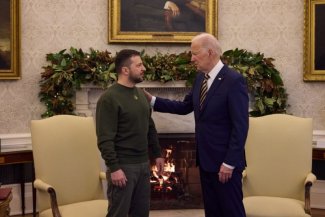The brotherhood of arms and values. Zelensky’s visit to Washington

On 21 December, President Volodymyr Zelensky paid a visit to Washington. It was his first foreign trip since the Russian invasion. During his remarks, he thanked the United States for its assistance so far and expressed hope for continued bipartisan support from Congress. President Joe Biden pledged ongoing support for Ukraine until a just peace is achieved and confirmed the delivery of another aid package – to the tune of $374 million – as well as $1.85 billion in military aid. The new military support package consists of two parts. The first ($1bn) includes, among others: a Patriot surface-to-air missile system battery with missiles, an unspecified number of missiles for HIMARS systems, HARM missiles and aerial bomb guidance (JDAM) kits, 500 155 mm precision munitions, 10 120 mm mortars and 10,000 grenades for them. The second ($850m), set aside by the Pentagon as part of the Ukraine Security Assistance Initiative, included US-acquired post-Soviet weaponry – 45,000 152 mm calibre artillery rounds, 20,000 122 mm calibre, 50,000 122 mm shells for Grad systems, 100,000 125 mm tank rounds – as well as satellite terminals and financial support.
Key elements of Zelensky’s visit were a meeting with Biden and a speech to Congress. The Ukrainian president stated that the condition for victory is the defeat of Russia on the battlefield, which can only be achieved with further military and financial assistance. He stressed that the conflict is not only about Ukraine’s territory and independence but also about the Kremlin’s brutally violated values and norms of international law. Zelensky argued that the outcome of the war would affect the current rules of international relations but would also define the conditions under which future generations would live. Creating a dichotomous picture of the struggle between good and evil, the leader appealed for the unity of the Western world in the war against the tyranny of the Russian dictatorship.
Commentary
- Zelensky’s first foreign visit after 24 February was aimed at reaffirming the US role as a key international partner of Ukraine and demonstrating the stability of the Kyiv government’s functioning despite the ongoing war. The president’s intention was also to mobilise US policymakers to increase military support and expand it with more advanced weaponry capable of effectively deterring missile attacks. The visit came in the final days of the ‘old’ Congress, which is expected to vote on a new $45 billion aid package for Ukraine – after the speech, House of Representatives Speaker Nancy Pelosi expressed hope that this would happen within 48 hours.
- Speaking in Congress, Zelensky appealed to representatives of both parties and directly to the American people. This aimed to reverse the negative trend on aid to Ukraine among the public due to the worsening economic situation. In recent months, the percentage of respondents supporting help for Kyiv for as long as it is needed has fallen from 58 to 48% (47%, meanwhile, favour calling on the Ukrainian capital to enter into peace negotiations if continued hostilities mean increased spending for the US household budget). Attitudes towards further support are deteriorating, especially among the electorate of the Republican Party, which will take a majority of seats in the House of Representatives in January. Zelensky’s speech and an announcement that the war with Russia had entered a decisive phase was therefore an attempt to counteract the decline in support for aid to Ukraine. It was also intended to convince a sceptical section of the Republican Party to continue aid.
- The announced military aid package is one of the largest in terms of value awarded to Ukraine since 24 February, and is the first in several months to include new categories of weaponry – the Patriot system and JDAM kits. From a military point of view, the most significant are the deliveries of ammunition for post-Soviet weaponry – its shortages have become one of the main reasons for the Ukrainian army’s reduction in activity in recent weeks.
- The transfer of the Patriot system, which Kyiv has been seeking since the beginning of the war, has an important symbolic function but does not represent significant support of a military nature. The package announces the delivery of one battery (5–8 launchers with command posts, radiolocation stations and security vehicles), whose personnel are to undergo training within a few months (normally it takes more than six months). This means an increase in the strength of Ukraine’s air defence in just one of the defended regions (most likely Kyiv), and this will not happen until spring 2023 at the earliest. Thus, during the most difficult winter period for Ukraine, its capabilities against enemy missile attacks will not be increased. It has not been announced what generation of Patriot system the invaded country will receive. However, it should be assumed that these will not be the latest PAC-3s. The price of such a battery in the basic variant with six launchers is estimated to be at least $1.1 billion, while the entire presidential part of the support package (Patriot is one of its components) is worth $1 billion.
- Contrary to a widespread interpretation in the media, Ukraine will not get guided bombs or systems that convert regular aerial bombs into guided bombs and increase their range to 24 km. The JDAM kit, consisting of a tail mechanism with control surfaces, an inertial guidance system and a GPS receiver, merely improves the accuracy of standard aerial bombs at their typical range. The timing and extent of the adaptation to JDAM use of aircraft operated by the Ukrainian Air Force remains an open question (most likely instrumentation to allow the use of HARM anti-radar missiles will be used).




